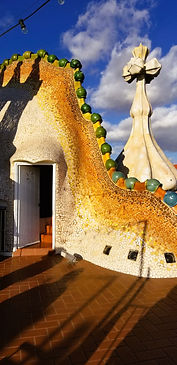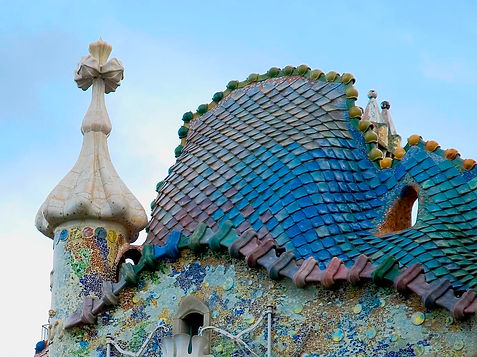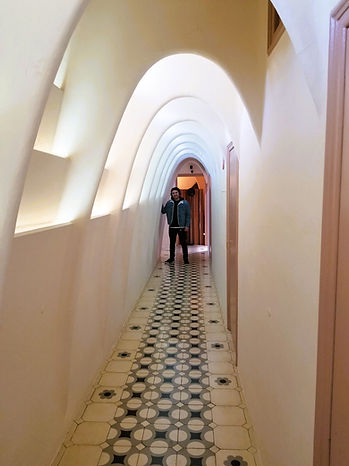Exploring Casa Batllo in Barcelona and its Fascinating Facts
Disclosure: When you click the ads on this page, I receive compensation that is at no cost to you. The compensation assists me in managing this website’s content free of charge for readers like you. Thank you for your support.
Barcelona is a city steeped in architectural wonders, and one of its most captivating gems is Casa Batllo. Designed by the legendary architect Antoni Gaudí, this modernist masterpiece is a testament to his genius and creativity. Casa Batllo is more than just a building; it's a work of art that continues to awe visitors from around the world. Below are some of the intriguing facts about this architectural marvel.



Inspired by the Sea
Casa Batllo's undulating facade is often likened to the waves of the Mediterranean Sea. Gaudí was inspired by the fluidity and dynamism of water, and this inspiration is evident in the curvaceous lines and the use of blue and green tiles on the exterior of the building.



No Straight Lines
One of Gaudí's signature design elements is the absence of straight lines in Casa Batllo. Everything from the walls to the windows to the doors is curved or rounded, creating a sense of organic unity throughout the building.



photo from flickr.com
A Dragon's Spine
The roof of Casa Batllo resembles the back of a dragon. The colorful mosaic tiles on the roof represent the dragon's scales, and the central turret is said to symbolize the dragon's head. This unique feature adds a touch of whimsy and fantasy to the building.

inner courtyard - photo from en.wikipedia.org
Natural Light Abundance
Gaudí was a master of natural light manipulation. Casa Batllo is designed to maximize the entry of sunlight into the interior spaces. The central lightwell, known as the "patio of lights," allows daylight to filter down into the lower floors, creating a bright and airy atmosphere.

Mythical and Symbolic Details
Throughout Casa Batllo, you'll find various symbolic and mythical elements. From the skeletal columns resembling human bones to the use of marine motifs, Gaudí incorporated rich symbolism into the design, inviting visitors to interpret the building's meaning in their own way.
Innovative Materials
Gaudí was known for pushing the boundaries of architectural materials. Casa Batllo features a wide range of innovative materials for its time, including the use of trencadís (mosaic made from broken tiles) on the facade and the use of reinforced concrete for structural elements.
Restoration and Preservation
Casa Batllo's restoration in the late 20th century was a labor of love. The building had fallen into disrepair over the years, but meticulous efforts were made to restore it to its original glory. Today, it stands as a beautifully preserved example of Gaudí's work.
Sustainable Design
Long before sustainability became a buzzword in architecture, Gaudí was incorporating eco-friendly elements into his designs. Casa Batllo's design allows for natural ventilation and lighting, reducing the need for artificial energy sources.

The Loft
The loft, characterized by its organic shapes and fluid lines, is a testament to Gaudí's commitment to blurring the lines between architecture and art. The use of natural light is a prominent feature, with large windows and skylights illuminating the space, creating an ethereal ambiance. Its unique design, influenced by marine and skeletal motifs, showcases Gaudí's obsession with detail and his dedication to creating an immersive, otherworldly experience within a residential setting. Thes arches are believed to represent the ribcage the dragon whose spine is represented in the roof. The Loft was formerly a service area where the laundry rooms and storage areas were located for the tenants of the building.


Saloon photo from en.wikipedia.org


Home to the Batllo Family
Originally built in 1877, Casa Batllo became the residence of the Batllo family after Gaudí's renovations in 1904. The family lived in the building for several decades, adding their own touches to the interior.
A UNESCO World Heritage Site
In 2005, Casa Batllo was designated a UNESCO World Heritage Site, recognizing its cultural and historical significance. It continues to be a popular destination for tourists and architecture enthusiasts alike.
Casa Batllo is a true masterpiece of architecture, a testament to Antoni Gaudí's boundless imagination and innovative spirit. Its unique design, rich symbolism, and attention to detail make it a must-visit attraction in Barcelona. As you explore this captivating building, remember these fascinating facts that add depth and meaning to the experience, and be prepared to be swept away by the magic of Casa Batllo.
